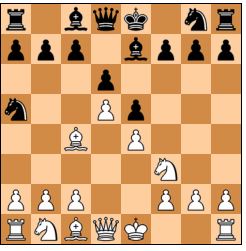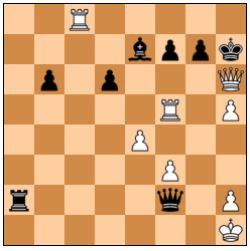I. You Evaluated Wrong!
As a chess trainer who has worked from players from beginner to master I am interested in what players of a given level need to improve on to progress to the next one. This article is the beginning of a series on various characteristic errors and how to improve in the situations where they occur.
Anyone trying to get better at chess is trying to make fewer mistakes. Generally speaking, any improvement begins with identifying the deficiencies and the sources of error. It is hard to try to correct a problem if a player is unaware of it. Certainly, it is easy to make mistakes in chess. As Tartakower said “The blunders are all there on the board, waiting to be made.” Which mistakes are made tend to have patterns that are influenced by the level of the player in question. By studying the errors that are typically made by players of a given level it can help a player progress without having to make all the mistakes themselves. Learning from the play of other players is one of the key ways to improve without having to learn everything from direct trial and error.
Chess is a game that has so many options that one must use good pattern recognition to be able to play well. A typical position will have 30 or more options, so giving each one deep consideration is simply not viable. One useful result of this reliance on patterns is that the mistakes made in chess games themselves have patterns that can be studied. Being more conscious of types of errors is helpful both in avoiding the errors and in exploiting those types of errors when an opponent makes them. Knowing about error patterns will not prevent errors completely, but being able to search for mistakes in a more systematic way should reduce the time and energy spent on that process considerably.
The concept I want to address in this article can manifest in two ways which I view as two sides of the same coin. The first one is the tendency to underestimate moves that appear to be serve a particular purpose, often a reactive one, but can create subtle or incidental threats. This sort of mistake is easy to make because the purpose for the opposing move has seemingly already been accounted for. An example would be 1. e4 e5 2. Nf3 Nc6 3. Bc4 Be7 4. d4 d6 5. d5 Na5?! 6. Bd3

Bd3 seems to be simply a response to a piece being en prise and needing a safeguard. But if Black continues with the casual 6... Nf6?? then 7. b4! Wins a piece. The key is that is that Bd3 has also left the knight on a5 with nowhere to go in addition to responding to its threat. Generally that sort of threat is harder to see than the threat earlier in the sequence 1. e4 e5 2. Nf3. In that case, one naturally looks at the knight that has just moved, making it easier to notice its attack on e5. Bd3 setting up a strong pawn move is far more of an implicit threat than a direct one, and thus it is much harder to see.
Moves that are retreating moves can be particularly hard to properly evaluate. In the prior example, Bd3 is not only a move that responds to the opponent's threat, but is also a retreating move, making it natural to overlook. We tend to think of threats being created when pieces move forward, when in fact this is not an absolute rule.
I managed to use an unexpected retreating move to win a piece against a grandmaster in a blitz game right out of the opening. That game began 1. Nf3 Nf6 2. c4 c5 3. Nc3 b6 4. e4 Bb7 5. e5 Ne4.
Black presumably expected that either I would trade off on e4 or that he would get a chance to trade off on c3. Instead I played 6. Nb1! Then it turns out that the knight on e4 has nowhere to go and after 6... h6 7. h4 (to prevent Ng5 when Black would only lose a pawn) Black lost a piece to d3 and soon resigned. 6... f6 would have at least prevented losing a piece but would still lead to a very bad position for black after 7. d3 winning a pawn.
In both examples, there is also the problem of making an apparently forceful knight move that just leaves the knight in danger of being trapped, creating an opposing threat that did not need to be there. One way to try to limit this kind of mistake is to think about what options the piece will have once the opponent responds to the move’s assertions. The main takeaway is mindset. Carefully considering the potential downside to seemingly aggressive moves and realizing a move an opponent makes in response to a threat can also contain a threat will help limit this kind of error.
The flip side of this is that noticing a strong move can be harder if there are many natural moves available that seem good. An example of a situation where a powerful move can easily be missed is 1. e4 e5 2. Nf3 Nc6 3. Nc3 Nf6 4. d4 exd4 5. Nxd4 Nxd4?! 6. Qxd4 Be7.
White has many natural developing moves available and it is easy to just make one without too much thought. That would miss a chance to seize a large advantage by playing 7. e5! In that case Nh5 loses a piece to g4 so Black winds up needing to play Ng8. Losing so much time in the opening like that though leads to a position that is already winning for White. Conversely, some tactics that are objectively much more complicated can be easier to notice if it's clear there is no real choice.

Magnus Carlsen just concluded the World Championship tiebreaker with a striking queen sacrifice to force checkmate (above). It came in a position where Karjakin was threatening several checkmates of his own. The result is that the difficult move is the one deciding to enter the line at all because once you are in the line the only way to avoid checkmate is to give checks yourself. Therefore, there are relatively few moves that are even worth analyzing. If you had the same position but with Black having no threat at all, it would be harder to see the mate because more moves would look ‘good’.
This idea has often been expressed as “If you see a good move, look for a better one.” Again, the main point is to have the mindset of questioning if there are better moves available. No one is going to see all the tactics all the time, but one will see many more tactics they at least attempt to find. The key is to think about what sort of weaknesses cause tactics to appear. This is where analyzing with an engine can be instructive. The engine will find many ideas that were not played. The way that is most useful is when the user thinks about why moves suggested by the engine work. By developing pattern recognition of the sorts of positions where unexpected tactics occur, we can spot them better going forward. This will make it easier (still not easy) to figure out when one should go beyond the routine move, and how to spot seemingly routine moves on the opposing side that are more dangerous than they appear.
Here is a short game that illustrates the dangers of being too quick to decide what the purpose of an opposing move is. 1. e4 c5 2. Nc3 d6 3. Nf3 a6 4. g3 g6 5. Bg2 Bg7 6. d3 Nc6 7. Be3 e5 8. Qd2 Nd4.
It seems like both sides are still developing and that Black simply played 8... Nd4 to place his knight in a strong square in the center. Because of this, White continued 9. Nd5? - but after Bh3! - he resigned because he cannot avoid losing material, one key line being 10. Nxd4 Bxg2 11. Rg1 cxd4 12. Rxg2 dxe3. (although the resignation is somewhat early since Black is only winning the exchange after 10. 0-0 Nxf3+ 11. Bxf3 Bxf1 12. Rxf1). The key was that White should have noticed that a potential Nxf3 forks the king and queen and that the knight is only protected by the bishop on g2. If White had noticed this, he would have been more likely to notice the potential danger and play something like Bxd4 or 0-0 (which does work because then Bh3 can be met by Bxd4 and then Bxg2 Kxg2).
In summary, it is important to be able to notice if there is more to a position than appears at first glance. Many moves that seem to do something simple like develop a piece also do more subtle things as well. This is especially true if one notices potential tactical weaknesses such as a badly defended piece or a piece that is vulnerable to being trapped. The very act of asking oneself what hidden resources could be present in the position can be helpful at uncovering hidden dangers. This also applies to the other side of this mistake which is making a routine move which overlooks a strong hidden resource in the position.
The basic rules that help us determine what moves to make and how to evaluate the moves our opponents make are not bad rules. They are just simple pattern associations which hold a slew of exceptions. But we do not need to handle these exceptions by verifying through absolute calculation every time – in fact, doing so would be impossible. We must simply understand that there are themes and trends to the exceptions to these broad rules, a next layer of pattern recognition that we must strive to understand if we want to improve as players.
|